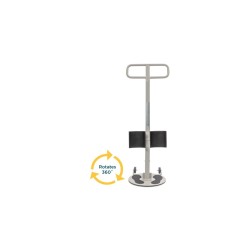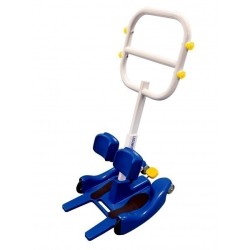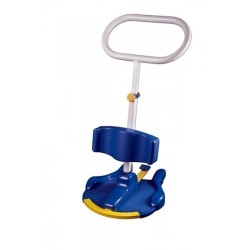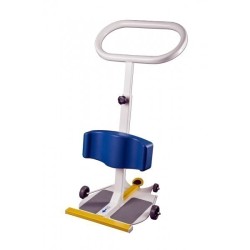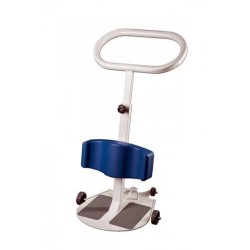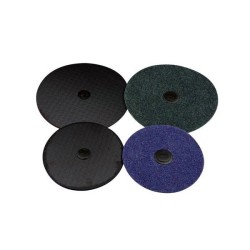Patient Turners
There are 8 products.
Active filters
About Patient Turners
Safe Patient Turning and Transfer Solutions
Patient turners provide specialised equipment enabling safe patient turning and assisted transfers, serving hospitals, care homes, rehabilitation facilities, and healthcare settings throughout England, Scotland, Wales, and Northern Ireland. These innovative mobility devices facilitate controlled patient rotation and standing assistance, combining stability support with smooth turning mechanisms enabling carers to assist patients with mobility limitations safely and efficiently. Healthcare environments utilise patient turners for assisting individuals with limited weight-bearing capacity but some standing ability, supporting transfers between seated surfaces including bed to chair or wheelchair to toilet, enabling safe turning during transfers reducing manual handling risks, facilitating rehabilitation exercises promoting standing and balance, and providing dignity-preserving assistance maintaining patient participation in transfers. Modern patient turners incorporate features including stable platforms supporting patient feet, padded support surfaces ensuring comfort, knee blocks preventing forward falls, grab rails providing stability, and smooth rotation mechanisms enabling controlled turning. The provision of patient turners demonstrates commitment to safe manual handling practice, reduces staff injury risks associated with awkward transfers, supports patient participation in mobility maintaining dignity, and enables efficient care delivery across professional healthcare environments.
The implementation of patient turners directly supports CQC compliance through enhanced staff safety, patient safety improvement, and demonstration of appropriate manual handling equipment provision meeting regulatory requirements. Manual handling injuries represent the most common occupational health problem in healthcare, causing staff absence and long-term disability, whilst patients face risks from unsafe transfers including falls and injury. Patient turners address these challenges by providing stable support during transfers reducing manual handling forces, enabling safer turning reducing staff musculoskeletal strain, facilitating controlled movement preventing patient falls, and promoting patient participation supporting dignity and therapeutic benefit. Clinical applications include post-operative mobilisation when patients can bear some weight but require assistance, stroke rehabilitation supporting standing practice and transfers, progressive neurological conditions enabling continued assisted transfers as abilities decline, frailty management supporting safe transfers whilst maintaining some independence, and temporary mobility limitation following illness supporting return to function. Healthcare organisations benefit from reduced staff injury rates when appropriate handling equipment is provided, decreased patient falls during transfers when stable equipment supports movement, enhanced efficiency through equipment facilitating quicker transfers, and improved satisfaction amongst staff appreciating manual handling injury prevention. Modern patient turners incorporate advanced features including battery-powered assistance reducing manual effort, adjustable components accommodating varied patient sizes, and compact designs throughout England, Scotland, Wales, and Northern Ireland.
Selecting and implementing patient turners requires assessment of patient populations, appropriate equipment specification, and comprehensive training across healthcare facilities throughout the UK. Organisations should evaluate typical patient capabilities determining who would benefit from turner assistance, assess environmental factors including space availability and transfer scenarios, and calculate equipment requirements based on usage patterns. Equipment selection should prioritise appropriate weight capacity matching patient needs, adjustable features accommodating varied users, stable construction ensuring safety, and ease of use encouraging consistent application. Implementation protocols must encompass comprehensive staff training on safe turner operation including patient assessment determining suitability, correct positioning and use, and emergency procedures if patients become unstable. Quality assurance measures should include regular equipment maintenance ensuring mechanical safety, documented service schedules, cleaning protocols preventing cross-contamination, and monitoring of turner-related incidents. Modern patient turners incorporate features such as antimicrobial surfaces, easily cleanable designs, and clear capacity markings. Organisations should establish clinical protocols identifying appropriate turner use, integrate turners with manual handling policies and risk assessments, and maintain equipment inventories tracking provision and maintenance. Individual care plans should document when patient turners are appropriate, specific techniques or precautions, and progression or regression in capabilities. Staff education should address recognition of patients suitable for turner assistance, those requiring alternative equipment such as hoists, and changed capabilities necessitating reassessment. Practice considerations should include adequate space for turner use, appropriate staffing levels, and supervision requirements. By implementing patient turners alongside professional manual handling protocols, healthcare organisations throughout England, Scotland, Wales, and Northern Ireland demonstrate their commitment to CQC standards, staff protection through manual handling injury prevention, patient safety during transfers, and provision of equipment that supports dignified, participative mobility enabling individuals to contribute to their own transfers whilst receiving necessary assistance and maintaining safety across all care settings.

